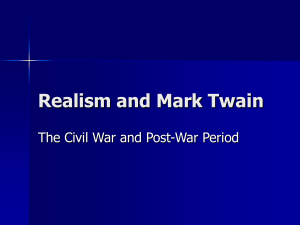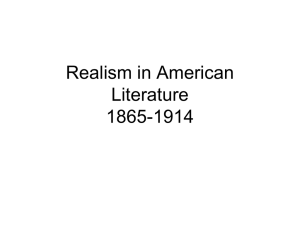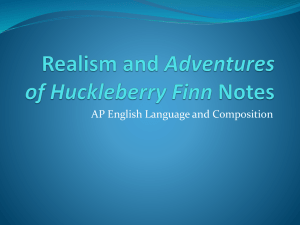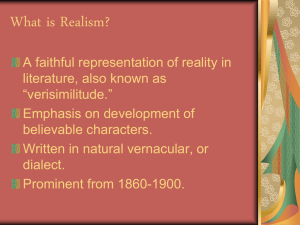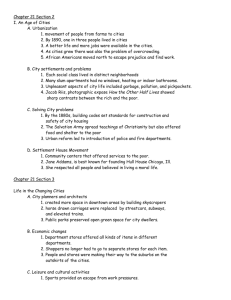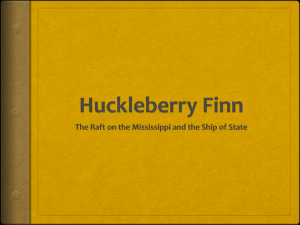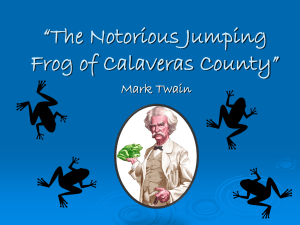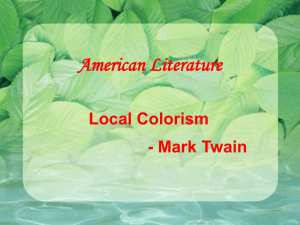Realism and Mark Twain
advertisement
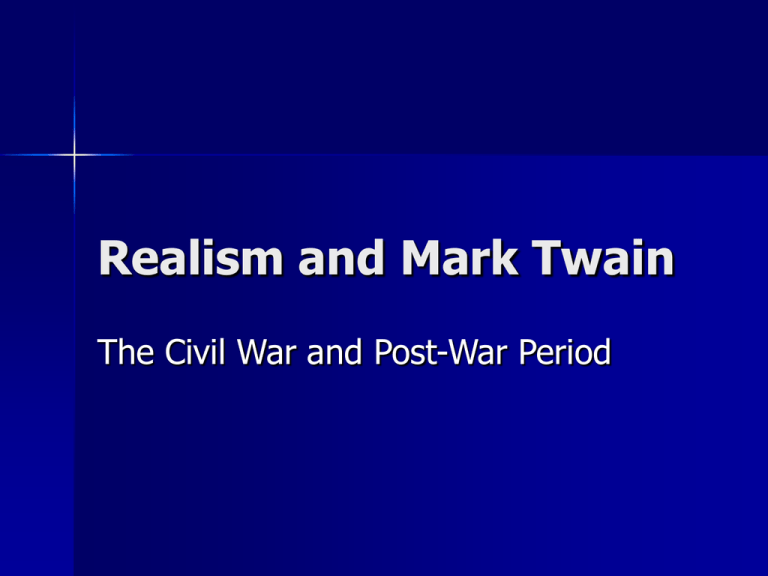
Realism and Mark Twain The Civil War and Post-War Period A reaction against romanticism, an interest in scientific method, the systematizing of the study of documentary history, and the influence of rational philosophy all affected the rise of realism. According to William Harmon and Hugh Holman, "Where romanticists transcend the immediate to find the ideal, and naturalists plumb the actual or superficial to find the scientific laws that control its actions, realists center their attention to a remarkable degree on the immediate, the here and now, the specific action, and the verifiable consequence" (A Handbook to Literature 428). In American literature, the term "realism" encompasses the period of time from the Civil War to the turn of the century during which William Dean Howells, Rebecca Harding Davis, Henry James, Mark Twain, and others wrote fiction devoted to accurate representation and an exploration of American lives in various contexts. As the United States grew rapidly after the Civil War, the increasing rates of democracy and literacy, the rapid growth in industrialism and urbanization, an expanding population base due to immigration, and a relative rise in middle-class affluence provided a fertile literary environment for readers interested in understanding these rapid shifts in culture. In drawing attention to this connection, Amy Kaplan has called realism a "strategy for imagining and managing the threats of social change" (Social Construction of American Realism ix). Plot and Character Character is more important than action and plot; complex ethical choices are often the subject. Characters appear in the real complexity of temperament and motive; they are in explicable relation to nature, to each other, to their social class, to their own past. Humans control their destinies; characters act on their environment rather than simply reacting to it. Renders reality closely and in comprehensive detail. Selective presentation of reality with an emphasis on verisimilitude, even at the expense of a well-made plot. Events will usually be plausible. Realistic novels avoid the sensational, dramatic elements of naturalistic novels and romances. Class is important; the novel has traditionally served the interests and aspirations of an insurgent middle class. Interpretation and analysis Realism is viewed as a realization of democracy. The morality of Realism is intrinsic, integral, relativistic – relations between people and society are explored. Realists were pragmatic, relativistic, democratic and experimental. The purpose of writing is to instruct and to entertain. Structure of Prose Diction is the natural vernacular, not heightened or poetic; tone may be comic, satiric, or matter-of-fact. The use of symbolism is controlled and limited; the realists depend more on the use of images. Objectivity in presentation becomes increasingly important: overt authorial comments or intrusions diminish as the century progresses. Mark Twain Born Samuel Langhorne Clemens in Florida, Missouri in 1835 At the age of four, he moved to Hannibal on the Mississippi River He eventually became a riverboat pilot; he derived the name Mark Twain from the riverboat leadsman’s signal “By the mark, Twain”- meaning the water was deep enough for safe passage Huck Finn was published in 1884 It received great public and critical acclaim. Facts about the novel time and place written · 1876–1883; Hartford, Connecticut, and Elmira, New York date of first publication · 1884 narrator · Huckleberry Finn point of view · Huck’s point of view, although Twain occasionally indulges in digressions in which he shows off his own ironic wit tone · Frequently ironic or mocking, particularly concerning adventure -novels and romances; also contemplative, as Huck seeks to decipher the world around him; sometimes boyish and exuberant tense · Immediate past setting (time) · Before the Civil War; roughly 1835–1845; Twain said the novel was set forty to fifty years before the time of its publication setting (place) · The Mississippi River town of St. Petersburg, Missouri; various locations along the river through Arkansas The Adventure of Huck Finn- Themes Themes Racism and slavery Intellectual and moral education The hypocrisy of “civilized” society Society’s values and laws can be in conflict with higher moral values. People must live outside of society to be truly free. Freedom means different things to different people. The novel also depicts Huck’s maturation and development. He distrusts the morals and precepts of a society that fails to protect him. He begins to question many of his teachings- especially those regarding race and slavery I’ll “go to hell” Even though written after slavery was abolished, things had not gotten much better for blacks in the South. We may read this story as an allegorical representation of the conditions of blacks in the US even after the abolition of slavery. Twain exposes the hypocrisy of slavery. Motifs Childhood Lies and Cons Superstitions and Folk Beliefs Parodies of Popular Romance Novels Symbols The Mississippi River- The ultimate symbol of freedom Land Shipwrecks Floods On a raft, away from society, he becomes free from society’s rules and makes his own conclusions. The river symbolizes freedom; the shore symbolizes civilization and the people who live in it. Satire https://www.examplesofsatire.com/ https://skeptically.org/cartoonsatire/ https://politicalhumor.about.com/
